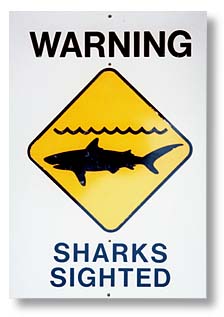


|
Maui site may get LAHAINA >> For the first time, the state is planning to post permanent shark-warning signs.
shark-warning sign
State plans for a sign posted
Thieves like signs
at Olowalu draw mixed reviewsBy Gary T. Kubota
gkubota@starbulletin.comThe signs will be posted at Olowalu in West Maui, where there have been three shark attacks, one fatal, and one encounter within the last 12 years. Two of those attacks happened within the last 28 months.
The plan is receiving mixed reactions on the Valley Isle.
A couple of charter boat operators said they are opposed to it and think it unfairly labels Olowalu as dangerous. But supporters say the attacks indicate a need for more caution, and the signs would warn the public, as well as avoid potential lawsuits against the state.
State officials usually post shark-warning signs in an area for 24 hours after a shark attack and then remove them if there are no further shark sightings.
Maui County aquatics chief Marian Feenstra said while she does not want to alarm the public, she supports the posting of some kind of shark-warning signs at Olowalu.
"I know that is an area of frequent sightings, so I would give the area high consideration for posting a sign," she said.
Charles Maxwell, native Hawaiian cultural specialist and member of the Shark Task Force, said he thinks posting of shark-warning signs is a "good idea" not only to protect the public, but also to protect the state from potential lawsuits.
Maxwell said he received a call from an attorney asking why no warning signs were posted permanently in areas where there have been shark attacks.
Officials say the Olowalu area is popular to snorkelers because it has an abundance of fish and turtles, but the ocean life also attracts sharks.

|
Randy Awo, the state enforcement chief on Maui, said Olowalu is generally known as a place where sharks congregate. Awo said while viewing the ocean by air, he has seen as many as 20 to 30 sharks in waters off Olowalu.A couple of charter boat operators say sharks are present all around Maui and that Olowalu is as safe as any other area.
"It's a great spot," said James Coon, the chief executive officer of Trilogy Excursions. "I hate to see it branded as not a great spot."
Gemini Charters General Manager Steve Dettwiler said shark attacks have taken place in a number of other areas on Maui in the last 60 years, and to put shark-warning signs at Olowalu will not be good for tourism.
State Shark Task Force spokesman Randy Honebrink said he is not inclined to post permanent warning signs where there has been a single shark attack but feels shark-warning signs at Olowalu would be appropriate.
Honebrink said he is reviewing shark-related warning signs used on the mainland and plans to obtain permission to post the signs from property owners along the Olowalu shoreline.
He said he is considering other ways to warn visitors, since some of them travel on snorkeling tours on a boat and would not see the signs.
Honebrink said the posting of permanent shark-warning signs does not require state Land Board approval and can be done administratively through the state aquatics division.
He said he has no timetable for when the signs will be posted but knows it will not be in the next month.
The idea of posting permanent warning signs at Olowalu follows a New Year's Day shark attack of a California man who was snorkeling with his girlfriend about 100 yards offshore in about 40 to 50 feet of water.
The victim -- Thomas Holmes, 35, of Los Angeles -- suffered cuts to his right buttock and both thighs from the tiger shark but survived after hitting the shark on the nose. There have been at least two other shark attacks and one encounter with a tiger shark at Olowalu.
Henrietta Musselwhite, 56, of Geyserville, Calif., suffered two large lacerations on her back and puncture wounds to a thigh when a shark attacked her in 30 feet of water about a half-mile offshore on Oct. 18, 2000.
A tiger shark bumped but did not injure a visitor during a diving tour at Olowalu in October 1998.
Maui resident Marti Morrel was killed by a shark in 1991 as she was swimming near her beachfront home in Olowalu.
Shortly after the attack earlier this month, Holmes and his girlfriend, Monica Boggs, said they were unaware of previous shark attacks and felt signs should be posted notifying visitors about the attacks.
LAHAINA >> State officials say they want to design a shark-warning sign that would be less attractive to thieves. Randy Honebrink said the shark-warning signs are among the ones stolen the most in Hawaii. Shark-warning signs
often attract thievesStar-Bulletin staff
Virtually all of the shark-warning signs posted after the New Year's Day shark attack were stolen overnight.
But state official Russell Sparks said enforcement officials recovered most of them at a campsite of teenagers the next morning.
Sparks said state officials posted 14 signs near Whalers Village at Kaanapali about three years ago, after a resident was attacked by a shark while swimming 300 yards offshore. Sparks said all but two signs were left standing in the morning.
"I thought it wouldn't be as bad there, but the tourists were worse," Sparks said.